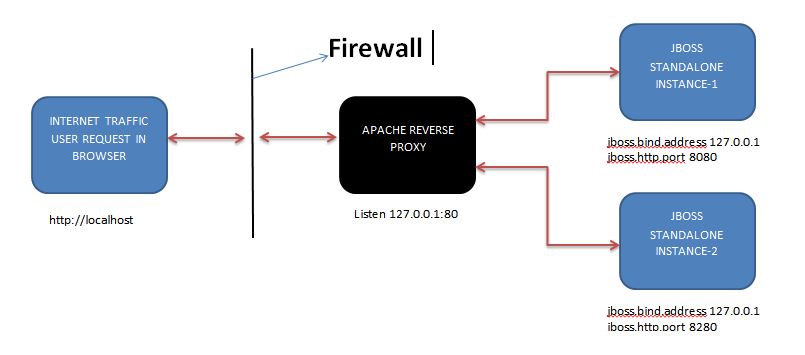In addition to being a 'basic' web server, and providing static and dynamic content to end-users, Apache httpd (as well as most other web servers) can also act as a reverse proxy server, also-known-as a 'gateway' server.
- Apache Proxy Configuration
- Apache Http Server Proxy Login
- Apache Proxy Ssl
- Apache Web Server Proxypass Https
In such scenarios, httpd itself does not generate or host the data, but rather the content is obtained by one or several backend servers, which normally have no direct connection to the external network. As httpd receives a request from a client, the request itself is proxied to one of these backend servers, which then handles the request, generates the content and then sends this content back to httpd, which then generates the actual HTTP response back to the client.
There are numerous reasons for such an implementation, but generally the typical rationales are due to security, high-availability, load-balancing and centralized authentication/authorization. It is critical in these implementations that the layout, design and architecture of the backend infrastructure (those servers which actually handle the requests) are insulated and protected from the outside; as far as the client is concerned, the reverse proxy server is the sole source of all content.
A typical implementation is below:
The reverse proxy terminates the HTTP request and forwards it to the ASP.NET app. A proxy server forwards client requests to another server instead of fulfilling requests itself. A reverse proxy forwards to a fixed destination, typically on behalf of arbitrary clients. In this guide, Apache is configured as the reverse proxy running on the same. After you download the WLS Web Server Proxy Plug-In for Apache HTTP Server, as described in Section 1.2, 'Availability of WLS Web Server Proxy Plug-In 12.1.2,', you can install it as an Apache HTTP Server module in your Apache HTTP Server installation. 3.2.1 Installation Prerequisites. Apache HTTP Server as Reverse Proxy This section contains examples of how the Apache Web Server (version 2.2.20) can be used as a proxy in front of SignServer. The guide is only informative, please consult the current Apache documentation for the modules used. The proxy can for example be used to.
The AJP request includes the original host header given to the proxy, and the application server can be expected to generate self-referential headers relative to this host, so no rewriting is necessary. The main exception is when the URL path on the proxy differs from that on the backend. Apache Traffic Server™ software is a fast, scalable and extensible HTTP/1.1 and HTTP/2 compliant caching proxy server. Formerly a commercial product, Yahoo! Donated it to the Apache Foundation, and currently used by several major CDNs and content owners.
If you are using a WebLogic Cluster you need a proxy in front of the cluster to provide load balancing. You need either a hardware load balancer or a Web Server with the Oracle Web server plug-in.
Even if you are not using a Cluster it makes sense to place a proxy in front of your WebLogic server to provide an extra layer of security. You can use the Apache HTTP Server with the mod_proxy module to configure a reverse proxy.
You can of cause also use the Oracle Web server plug-in but it is a proprietary module that you have to manually download and install. mod_proxy is open source and since I mostly work with Red Hat servers it is available in the standard Red Hat channel. Red Hat provide security updates so 'all' you have to do is run yum update once in a while to get the latest updates. If you use the Oracle Web server plug-in you have to manually check for updates.
I often you use a solution where an Apache HTTP Server is placed in a DMZ network segment. SSL is terminated at the Apache server and mod_proxy is used to proxy requests to an WebLogic Server in the production network segment.

In this example we have an Internet domain called theheat.dk. The public IP 217.116.232.220 is NATed to 10.10.10.1 on winterfell.
Apache has already been installed on winterfell, the mod_proxy module loaded, SSL configured and WebLogic is running on wintermute.
In your VirtualHost in the ssl.conf (httpd-ssl.conf on Windows) file you can add something like this:


In this example we have an Internet domain called theheat.dk. The public IP 217.116.232.220 is NATed to 10.10.10.1 on winterfell.
Apache has already been installed on winterfell, the mod_proxy module loaded, SSL configured and WebLogic is running on wintermute.
In your VirtualHost in the ssl.conf (httpd-ssl.conf on Windows) file you can add something like this:
The ProxyPass and ProxyPassReverse directives are used to forward all requests to the WebLogic Server running on 10.10.10.10.
Another example:
Apache Proxy Configuration
Here only requests matching two specific paths are forwarded to two Web Services.
If you need more control over what is proxied you can use the ProxyPassMatch directive.
If you want to prevent a path from being proxied you can use the ! directive.
Configure the WebLogic Server to use a proxy
The above will proxy the requests to the WebLogic Server.
In some situations it will not work though. The WebLogic Server does not know that there is a proxy in front of it and sometimes it will return URLs to the end-user that contains the server name. In this example it will return URLs that contain wintermute. Since wintermute is not known on the Internet it will fail.
I have experienced this when an ADF application session timeout and asks the user to log in again. The URL returned to the user is wrong.
Another example is the WSDL for a Web Service. The location of the end-point and references to XML schemas will use the host name.
To remedy this you can configure WebLogic so I knows that there is a proxy in front of it. WebLogic will use this information and dynamically change the references, so they uses the proxy information.
First you must enable the WebLogic Plug-In. We are not using the WebLogic Plug-In but we still need to enable it here.
Domain Structure > Environment > Servers > managed01 > Configuration General > Advanced:
Next you must insert the proxy and port.
Domain Structure > Environment > Servers > managed01 > Protocols > HTTP:
The little yellow triangles with the exclamation mark tell us that we need to restart the WebLogic server for the changes to take effect.
Apache Http Server Proxy Login
But it will still not work. We have told WebLogic what the frontend HTTPS host and port is, but we have terminated SSL at the Apache proxy and uses HTTP between Apache and WebLogic.
We need to tell WebLogic that the proxy was originally called with HTTPS.
We do this by inserting an tag in the HTTP header in the Apache configuration:
Apache Proxy Ssl
Citrix receiver for chrome download. Now everything should be working.
If you are using a cluster you should set Frontend Host and Frontend HTTPS Port for the cluster not the individual Managed Server. For more information:
http://goo.gl/k0jUe
ProxyPreserveHost
In some situations you need to access your application from both the Internet and from an internal network segment using the internal server names.
To accomplish this you need to change the Apache configuration:
Setting 'ProxyPreserveHost On' will tell Apache to pass the host used in the request to the WebLogic Server.
You also need to remove the Frontend HTTPS Host from you WebLogic Server or Cluster.
Now I can access a Web Service via both:
https://theheat.dk/service/ws1?WSDL
And:
https://winterfell/service/ws1?WSDL
The WSDL will either contain reference to theheat.dk or winterfell depending of which URL I use to access the WSDL with.

